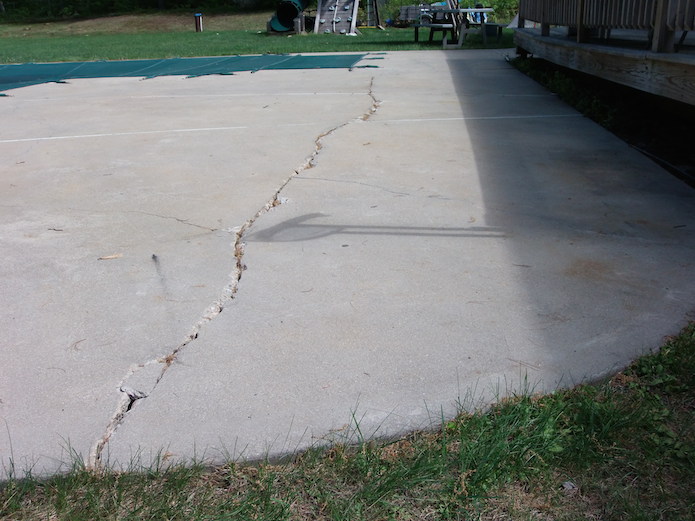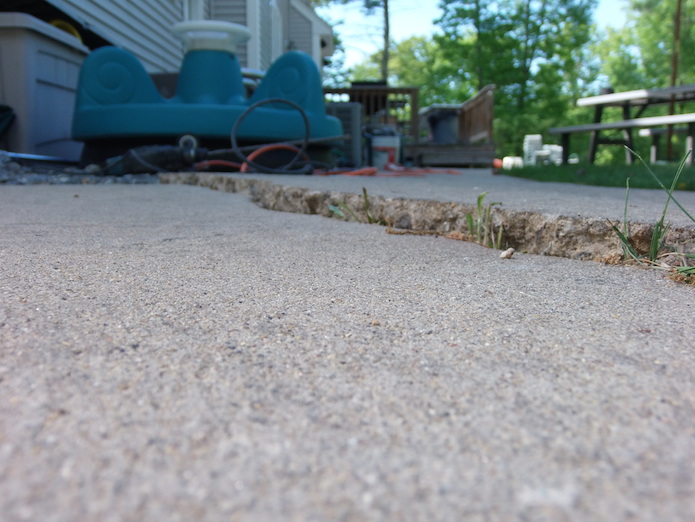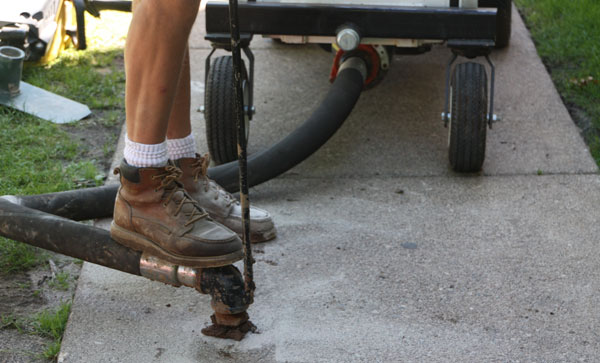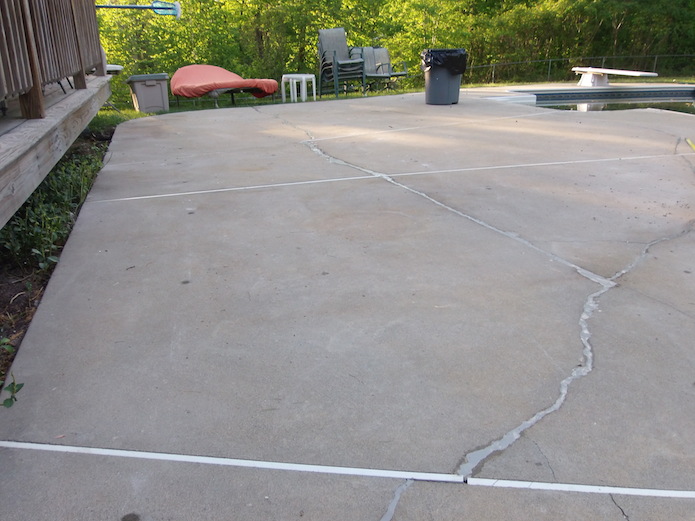what to do with a sinking cracking patio
You don't need to supervene upon your whole patio to make it look like new once more.
Summertime is upon us, which ways plenty of cook-outs, lounging by the puddle, and entertaining friends in our favorite outdoor spaces.
From puddle patios to front walkways, a good number of homes these days utilize physical slabs and surfaces. Much like other features of a home, these patios and walkways demand repair from fourth dimension to time due to erosion, settlement, and general vesture and tear. These repairs don't need to affect your decorated summer schedule though, as in that location are quick ways and new products to address your patio issues.
Why is my patio croaky?
The number one effect with outdoor patios is settling or sinking. When a patio settles, it typically does so in various sections and unevenly, which leads to unstable, wobbly surfaces. Cracks will also form as the weight of the concrete surface will no longer exist supported evenly underneath. Leaving the patio or walkway in this condition volition lead to stubbed toes, leaning furniture, and an overall undesirable place (particularly with those unsightly cracks!).
How exercise I fix it?
So, what causes a patio to settle in the kickoff identify? Prior to the physical existence installed, the ground is prepared by compacting the earth underneath with heavy mechanism. In most cases, this compacted surface will either be gravel or at least covered with a layer of gravel. These steps are taken to forbid the footing from settling under the weight of the patio installed above. Even so, sometimes settlement is inevitable due to weather conditions, namely pelting h2o washing away the soil underneath. Also, sometimes the compacting is non done correctly or thoroughly enough.
Selection 1: Replace the whole thing

The commencement fashion most homeowners think of to accost their settling patio is to simply replace it. Seems uncomplicated enough, right?
Simply this method is not and so simple. Replacing the unabridged patio will first crave you to remove any furniture you may have on the surface, as well as any plants or landscaping which may be forth the borders. Then you're in for lots of labor, new materials, and pes traffic through your property. Fifty-fifty though it seems like the most obvious choice, replacing the whole patio is the well-nigh expensive and fourth dimension consuming option on the table. So what else can you do?
Pick 2: Resurface the top

If replacing the patio doesn't sound like your loving cup of tea, resurfacing it might audio similar a better option. Withal, resurfacing the patio'southward top only hides the real issue. While cracks and furrows may now be out of sight, the initial problem of sinking and settling has left voids under the patio, and these holes will all the same be. Severe voids will crusade the patio slabs to stone from side to side, causing an annoying, and potentially unsafe, state of affairs. Besides, should the edge of your resurfaced patio be a part of a step, this pace will now be college, perhaps not meeting local codes and posing a run a risk.
Selection 3: Mudjacking

Mudjacking utilizes a mortar-based mixture which is injected into holes and cracks in the patio slab and pumped underneath the surface. The mixture fills all the voids and has enough force to raise uneven slabs to meet their neighbor, closing any cracks or holes. It then hardens, and prevents any further rocking or movement from occurring.
As mudjacking involves a mortar mix material, it does require a bit of labor and heavy fabric—so it'due south not something you'd want to DIY. Mudjacking repairs may also be subject to erosion, every bit the material used is mortar based. The terminal, solid product underneath is also somewhat heavy, and its weight sometimes exacerbates the settling problem, leading to fifty-fifty more sinking in the future.
Choice 3: Polymer slab lifting

The most recent advancement in patio repair is polymer slab lifting, which serves equally an alternative to mudjacking that offers a lighter textile and fewer followup bug. Similar to mudjacking, the polymer material (usually polyurethane) is injected into holes and cracks in the patio's slabs, and then pumped underneath the surface of the patio, filling all voids and binding with the soil. As the material solidifies, it expands at a rapid rate, and then lifts the concrete surface to where information technology needs to be.
Unlike mortar mixtures, the fabric used in polymer slab lifting is surprisingly low-cal, nonetheless equally stiff. The cleanup is also quick, as there is no excess, dirty cloth to accept to wash away or clean with water. In one case all the lifting is consummate, all that's left to do is a unproblematic process of sealing cracks and adding the finishing touches to the patio's newly filled and leveled surface.
Keep in mind, for patios composed of numerous smaller stones or pavers, mudjacking and polymer slab lifting will not always be applicable, as it is not possible to lift such small pieces uniformly. Different bug will call for different solutions, and and so it is e'er advisable to call a local professional for large patios or walkways which may be facing settlement bug. Quotes should by and large be complimentary of charge, and you'll and then have a proficient idea of the time frame and toll involved for getting your infinite back into tip-top shape.
Do you need advice on whether your patio is worth salvaging?
Request a Patio Contractor
Top Image Credit: Charles Vincent George Architects
Source: https://porch.com/advice/the-best-way-to-fix-a-cracked-patio